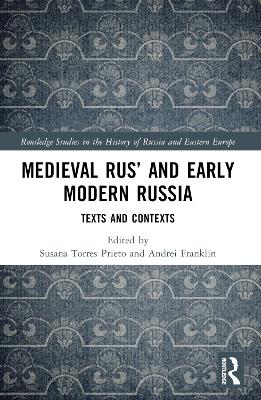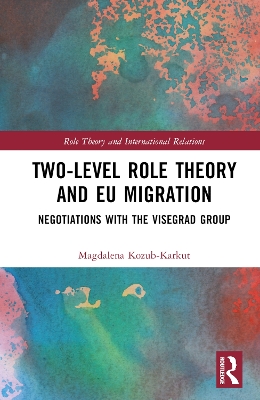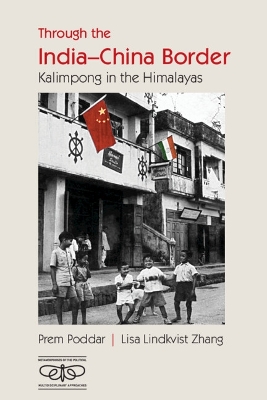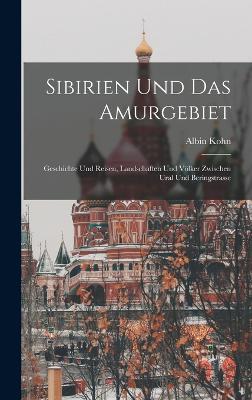Medieval Rus' and Early Modern Russia
 portes grátis
portes grátis
Medieval Rus' and Early Modern Russia
Texts and Contexts
Franklin, Andrei; Torres Prieto, Susana
Taylor & Francis Ltd
10/2024
252
Mole
9781032187860
15 a 20 dias
Descrição não disponível.
Section I: Use of Byzantine models and sources
Leo VI and the Transformation of Byzantine Strategic Thinking about the Rus'
Who Was 'Theodore the Rhos from a Family of Emperors', the Owner of the Stone from the Holy Sepulchre?
Cosmos, Calendars and Medical Advice in the Miscellanies of the Trinity Lavra of St. Sergius and their Late Byzantine Counterparts (14th-early 16th centuries)
Holy Foolishness and Gender Transgression in Russian Hagiography from the Middle Ages to Modernity
Section II: Historiography and Construction of Historical Narratives
Some Unnoticed Greek Quotes in Old Russian Chronicles
Retranslating the Rus' Primary Chronicle: Perspectives on Horace Lunt's New Rendering
Two emperors of the princess Olga's visit to Constantinople: Constantine VII Porphyrogenitos versus John Tzimiskes in the copies of the Rus' Primary Chronicle
Patriarch Germanus II of Constantinople and the Slavic world
Thoughtful Agglomeration: Late Byzantine Sources for Muscovite Ceremonial
Boris Godunov and his family in the mirror of medieval Russian polyonymy
Section III: Material Supports of Written Texts
"I must be cruel only to be kind": towards a literary history of Kyiv graffito No. 108
Muscovite Acquisition of Books from Poland in the Late 1640s-Early 1650s
The Codex in Early Rus' between the 11th-15th centuries: variations of form and variations of function
Section IV: Social Repercussions of the Graphosphere
Sofiia Vitovtovna's Dance: The Wedding of Vasilii II in Russian Cultural Memory
Revolution in the Pictosphere: The Ukrainian Baroque and Muscovite Reception
Leo VI and the Transformation of Byzantine Strategic Thinking about the Rus'
Who Was 'Theodore the Rhos from a Family of Emperors', the Owner of the Stone from the Holy Sepulchre?
Cosmos, Calendars and Medical Advice in the Miscellanies of the Trinity Lavra of St. Sergius and their Late Byzantine Counterparts (14th-early 16th centuries)
Holy Foolishness and Gender Transgression in Russian Hagiography from the Middle Ages to Modernity
Section II: Historiography and Construction of Historical Narratives
Some Unnoticed Greek Quotes in Old Russian Chronicles
Retranslating the Rus' Primary Chronicle: Perspectives on Horace Lunt's New Rendering
Two emperors of the princess Olga's visit to Constantinople: Constantine VII Porphyrogenitos versus John Tzimiskes in the copies of the Rus' Primary Chronicle
Patriarch Germanus II of Constantinople and the Slavic world
Thoughtful Agglomeration: Late Byzantine Sources for Muscovite Ceremonial
Boris Godunov and his family in the mirror of medieval Russian polyonymy
Section III: Material Supports of Written Texts
"I must be cruel only to be kind": towards a literary history of Kyiv graffito No. 108
Muscovite Acquisition of Books from Poland in the Late 1640s-Early 1650s
The Codex in Early Rus' between the 11th-15th centuries: variations of form and variations of function
Section IV: Social Repercussions of the Graphosphere
Sofiia Vitovtovna's Dance: The Wedding of Vasilii II in Russian Cultural Memory
Revolution in the Pictosphere: The Ukrainian Baroque and Muscovite Reception
Este título pertence ao(s) assunto(s) indicados(s). Para ver outros títulos clique no assunto desejado.
Early Modern History;Medieval History;East slavs;Early Modern Russia;Medieval Rus';Medieval Rus;Primary Chronicle;Early Rus;East Slavic;RGB;Holy Foolishness;Vasilii II;Church Slavonic;Slavic Translation;Constantine VII;Theodore Stratelates;Vice Versa;Patriarch Germanus;Leo VI;Dmitrii Donskoi;Constantine Porphyrogenitos;Holy Fool;Metropolitan Kirill;John Tzimiskes;Golden Belt;Germanus II;Synodal Decree;Kyiv Metropolitanate;Holy Sepulchre
Section I: Use of Byzantine models and sources
Leo VI and the Transformation of Byzantine Strategic Thinking about the Rus'
Who Was 'Theodore the Rhos from a Family of Emperors', the Owner of the Stone from the Holy Sepulchre?
Cosmos, Calendars and Medical Advice in the Miscellanies of the Trinity Lavra of St. Sergius and their Late Byzantine Counterparts (14th-early 16th centuries)
Holy Foolishness and Gender Transgression in Russian Hagiography from the Middle Ages to Modernity
Section II: Historiography and Construction of Historical Narratives
Some Unnoticed Greek Quotes in Old Russian Chronicles
Retranslating the Rus' Primary Chronicle: Perspectives on Horace Lunt's New Rendering
Two emperors of the princess Olga's visit to Constantinople: Constantine VII Porphyrogenitos versus John Tzimiskes in the copies of the Rus' Primary Chronicle
Patriarch Germanus II of Constantinople and the Slavic world
Thoughtful Agglomeration: Late Byzantine Sources for Muscovite Ceremonial
Boris Godunov and his family in the mirror of medieval Russian polyonymy
Section III: Material Supports of Written Texts
"I must be cruel only to be kind": towards a literary history of Kyiv graffito No. 108
Muscovite Acquisition of Books from Poland in the Late 1640s-Early 1650s
The Codex in Early Rus' between the 11th-15th centuries: variations of form and variations of function
Section IV: Social Repercussions of the Graphosphere
Sofiia Vitovtovna's Dance: The Wedding of Vasilii II in Russian Cultural Memory
Revolution in the Pictosphere: The Ukrainian Baroque and Muscovite Reception
Leo VI and the Transformation of Byzantine Strategic Thinking about the Rus'
Who Was 'Theodore the Rhos from a Family of Emperors', the Owner of the Stone from the Holy Sepulchre?
Cosmos, Calendars and Medical Advice in the Miscellanies of the Trinity Lavra of St. Sergius and their Late Byzantine Counterparts (14th-early 16th centuries)
Holy Foolishness and Gender Transgression in Russian Hagiography from the Middle Ages to Modernity
Section II: Historiography and Construction of Historical Narratives
Some Unnoticed Greek Quotes in Old Russian Chronicles
Retranslating the Rus' Primary Chronicle: Perspectives on Horace Lunt's New Rendering
Two emperors of the princess Olga's visit to Constantinople: Constantine VII Porphyrogenitos versus John Tzimiskes in the copies of the Rus' Primary Chronicle
Patriarch Germanus II of Constantinople and the Slavic world
Thoughtful Agglomeration: Late Byzantine Sources for Muscovite Ceremonial
Boris Godunov and his family in the mirror of medieval Russian polyonymy
Section III: Material Supports of Written Texts
"I must be cruel only to be kind": towards a literary history of Kyiv graffito No. 108
Muscovite Acquisition of Books from Poland in the Late 1640s-Early 1650s
The Codex in Early Rus' between the 11th-15th centuries: variations of form and variations of function
Section IV: Social Repercussions of the Graphosphere
Sofiia Vitovtovna's Dance: The Wedding of Vasilii II in Russian Cultural Memory
Revolution in the Pictosphere: The Ukrainian Baroque and Muscovite Reception
Este título pertence ao(s) assunto(s) indicados(s). Para ver outros títulos clique no assunto desejado.
Early Modern History;Medieval History;East slavs;Early Modern Russia;Medieval Rus';Medieval Rus;Primary Chronicle;Early Rus;East Slavic;RGB;Holy Foolishness;Vasilii II;Church Slavonic;Slavic Translation;Constantine VII;Theodore Stratelates;Vice Versa;Patriarch Germanus;Leo VI;Dmitrii Donskoi;Constantine Porphyrogenitos;Holy Fool;Metropolitan Kirill;John Tzimiskes;Golden Belt;Germanus II;Synodal Decree;Kyiv Metropolitanate;Holy Sepulchre







